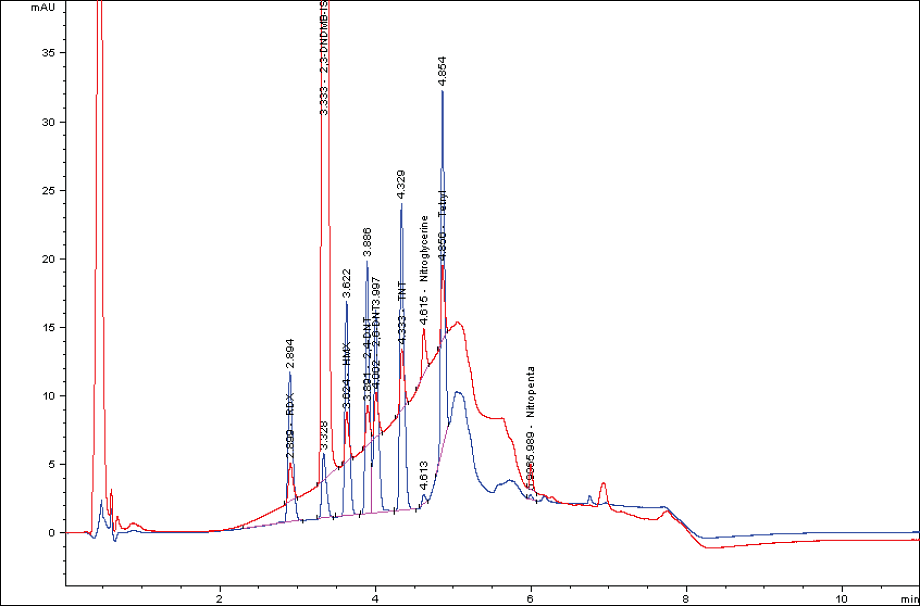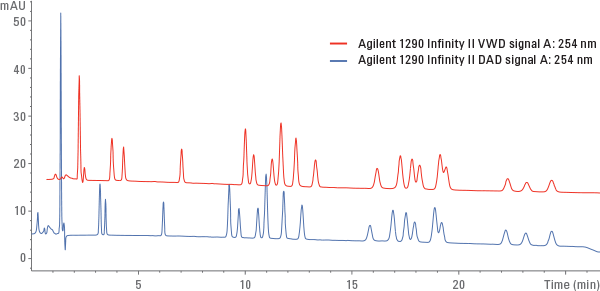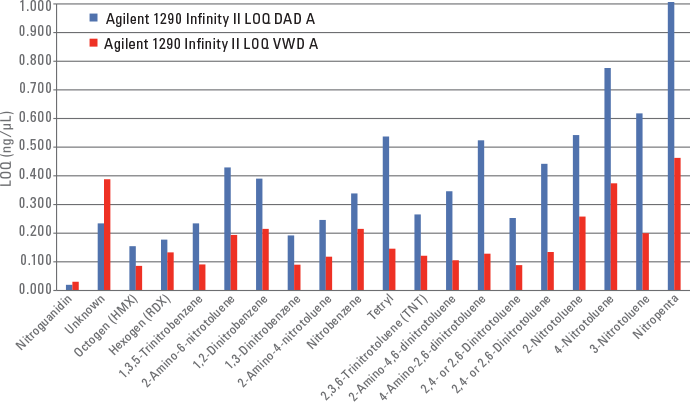Access Agilent eNewsletter April 2015
>> Update My Profile | Subscribe to Access Agilent | Article Directory

Optimize detection of explosive residues with Agilent LC/VWD/DAD
By Edgar Naegele and Sonja Schneider
Agilent Applications Chemists
and Detlef Wilhelm
AnaTox GmbH & Co., Germany
Long after the bang, explosive residues can remain in soil, water, and other matrices, posing additional threats to human and animal health. Detecting and identifying residues at the site of an explosion is therefore extremely important. Samples can include soil from former military training grounds or from sites of controlled detonation. Similarly, analysis of explosive residues remains an essential component of forensic investigations. Agilent has produced many applications for analyzing explosive residues from different matrices. Most recently, the introduction of the new Agilent 1290 Infinity II LC has expanded the range of solutions for these analyses.
 Enlarge
Enlarge Figure 1. Detection of a 1 µg/mL explosive standard with the Agilent 10-mm Max-Light Cartridge Cell (red) and 60-mm High Sensitivity Cell (blue) at 235 nm.
Method optimization for fast LC
For this application, we transferred a method for eight explosives and an internal standard from standard materials to Agilent Rapid Resolution High Definition or Rapid Resolution High Throughput columns. A ZORBAX StableBond SB-CN column delivered the best selectivity, as identified by the Agilent method development system, and reduced the run time to seven minutes with no matrix influences. Effective gradient mixing using low volume Agilent V380 Jet Weaver provided reproducible gradients that increased the precision of retention time. All criteria were also met for the precision of areas, retention times, and peak resolution. The coefficients for linearity for all explosive components were better than 0.999. Sensitivity was improved by using the 60 mm High Sensitivity Cell for the lowest detection limit (Figure 1). Full details of this work are available in the free Agilent publication 5990-8084EN.
Fine-tuning with dual wavelength detection
Highly explosive nitroaromatics are organic compounds with one or more nitro functional groups (-NO2) directly attached to an aromatic group. Increasing the number of nitro groups increases the compound’s explosive power. US Environmental Protection Agency (EPA) 8330A/B1 describes a method for sensitive analysis of nitroaromatics and nitramines by LC/UV.
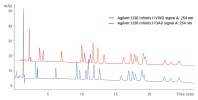 Enlarge
Enlarge Figure 2. Agilent 1290 Infinity II DAD and Agilent 1290 Infinity II VWD signals at 254 nm showing similar sensitivity and resolution.
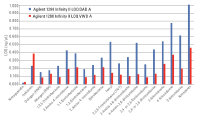 Enlarge
Enlarge Figure 3. Comparison of the limits of quantification for the Agilent 1290 Infinity II DAD and Agilent 1290 Infinity II VWD at 254 nm. For most of the analytes, the VWD showed more than double the sensitivity compared to the DAD.
In this trial, we analyzed a standard mix of 20 explosives that also included nitropenta, a compound that does not contain an aromatic group. Detection of the different explosives required two wavelengths facilitated by the dual-wavelength functions of the fast and sensitive Agilent 1290 Infinity II Variable Wavelength Detector (VWD). The time-programmable wavelength switching available with the Agilent 1290 Infinity II LC provided rapid changeover between wavelengths, improved selectivity, and delivered high sensitivity. Low detector noise (< ± 1.5 µAU) and baseline drift (< 1 × 10–4 AU/h) facilitated precise trace-level quantification of explosive residues.
We also compared detection performance of the VWD with the Agilent 1290 Infinity II Diode Array Detector (DAD). Figure 2 shows an overlay of the 254 nm signals collected with the DAD (blue signal) and the VWD (red). Both chromatograms demonstrate comparable sensitivity and resolution.
The comparison of LOD and LOQ showed higher sensitivity for all peaks (except for the first two) with the 1290 Infinity II VWD. In most cases, the VWD provided twice the sensitivity of the DAD. Linearity calculations using a series of 1:2 dilutions of the explosive standards (10 ng/µL each to 0.625 ng/µL) yielded comparable performance between the DAD and VWD with correlation coefficients over 0.9999 for most analytes. Agilent publication 5991-5463EN gives complete details of these investigations.
Agilent offers a wide range of environmental testing solutions and services
Agilent is the market leader in environmental analysis and regulatory compliance. With more than 40 year’s experience, Agilent has the analytical solutions, instruments, consumables, and services to meet your requirements for all types of organic and inorganic analysis. Explore the full range of Agilent environmental solutions and see for yourself how Agilent can improve the speed, accuracy, and productivity of your laboratory.
>> Update My Profile | Subscribe to Access Agilent | Article Directory
